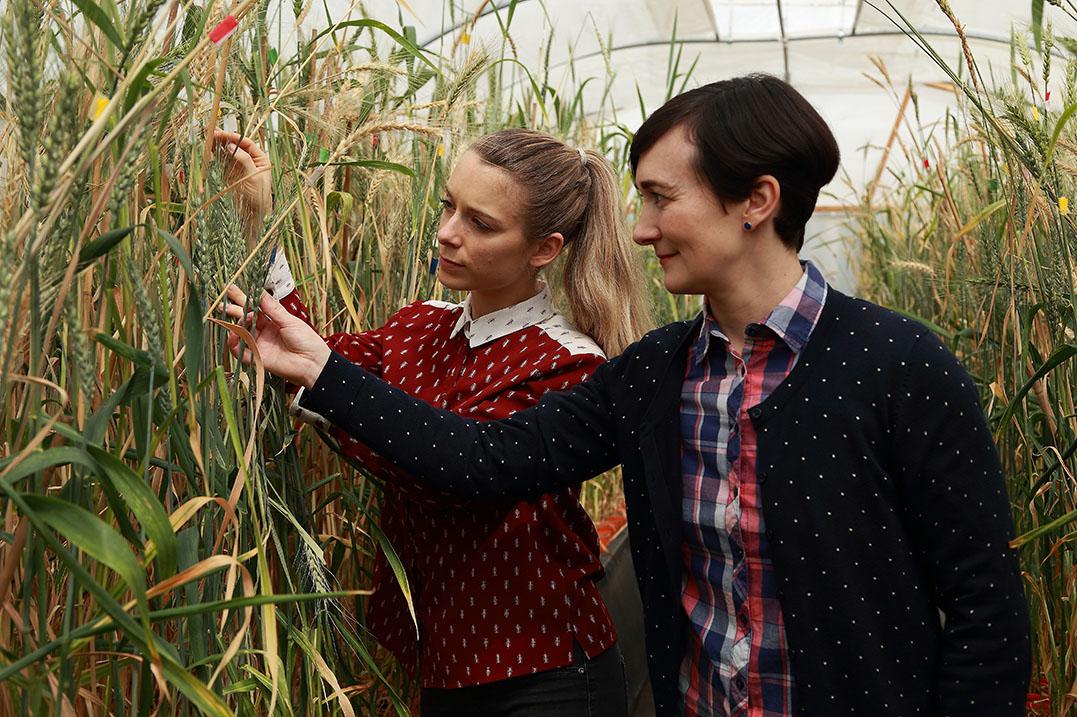Adelaide, Australia
February 26, 2020

PhD graduate Dr Jessica Schmidt and her PhD co-supervisor Dr Delphine Fleury inspect wheat plants for stress tolerance
Scientists have developed a computed tomography (CT) scanning method for screening large samples of wheat for drought and heat tolerance.
They believe the new system will allow more accurate and much more rapid analysis of wheat heads, speeding up the process of breeding for plants better adapted to climate change. It will also enable researchers to analyse some grain traits automatically that have been difficult, if not impossible, to do so manually.
The study is a collaboration between the University of Adelaide’s School of Agriculture, Food and Wine in Australia and the Fraunhofer Institute for Integrated Circuits’ Development Center for X-ray Technology in Germany.
Scientists at the University of Adelaide-based Australian Research Council (ARC) Industrial Transformation Research Hub for Wheat in a Hot and Dry Climate and The Plant Accelerator and the Fraunhofer Institute say their new method will allow researchers to measure grain traits with a high degree of accuracy and fast throughput. Their work has been published in the journal Plant Methods .
“This system enables not just a much more accurate but also faster solution to determine even the smallest differences in grain characteristics."Dr Jessica Schmidt
Recent University of Adelaide PhD graduate and lead author Dr Jessica Schmidt says that, in order to identify genes responsible for grain yield and stress tolerance, researchers need precise analysis of grain yield components along each wheat head.
Currently yield data is obtained by crude machine threshing from field trials with lots of seeds lost or destroyed or, in the case of greenhouse trials, often by laborious, costly and time-consuming hand-threshing and manual measurements.
“This system enables not just a much more accurate but also faster solution to determine even the smallest differences in grain characteristics,” she says. “This allows us to compare a much larger number of genetically different plants, important for identifying genomic regions and stress mechanisms that will enable plants to do well under climate change.
“It also allows us to analyse traits which were either very difficult and/or time-consuming to analyse such as grain size, grain morphology and grain weight along the spike which is relevant when stresses occur at different timepoints of development. For instance, we have observed certain types of seed morphologies caused by drought and heat stress in previous years but were never able to categorise or analyse them.”
Scientific Director at the Adelaide node of the Australian Plant Phenomics Facility, Dr Bettina Berger, says: “Importantly this method can be automated – enabling us to measure, with high resolution, one hundred thousand wheat heads in only a couple of months. This means we’ll be able to analyse the grain from large scale genetic studies and breeding programs where hundreds of thousands of cereal heads have to be assessed every year.”
Fraunhofer Institute IIS researcher Joelle Claussen says: “Computed tomography is a well-established technique in medicine but attempts to adapt it for plant phenotyping have had some technical issues to solve.
“We’ve been able to develop a system that enables much faster scanning as well as reconstructing morphological changes characteristic of wheat grown under stress. It’s a robust, fast and accurate system for assessing varieties for improved yield and climate resilience.”